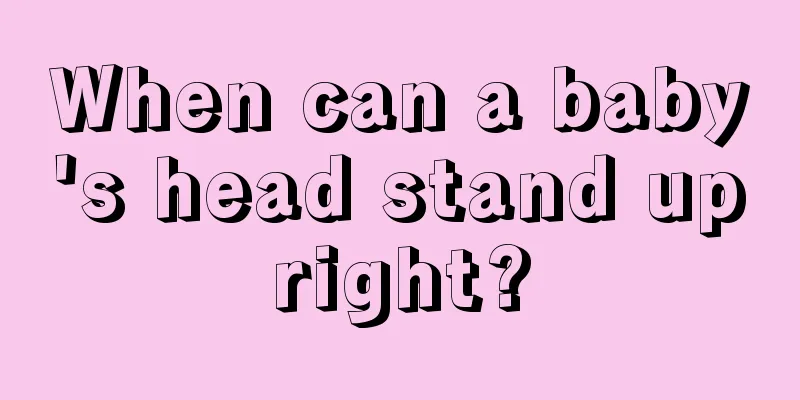When can a baby's head stand upright?

|
We all know that babies are usually held horizontally when they are young, but as they grow older, they will begin to learn various skills. For example, counting with their heads is also a sign of growth. Generally speaking, after four months, the baby's head and trunk can be lifted up, and the head can be held upright steadily and turned left and right. 1. Pull-up sitting posture and head upright The infant lies on his back with his head in the middle position. The examiner supports the baby's forearms on both sides and slowly pulls the baby up to 45 degrees, observes whether the baby can lift his head, and then pulls the baby into a sitting position to observe whether the baby can hold his head upright. Normal: When a one-month-old child is pulled up, the head droops backward, but the head can remain upright for 5 seconds when sitting; when a 2-3-month-old child has a slight droop in the head, the head can remain upright for more than 15 seconds; when a four-month-old child is pulled up, the head and trunk are lifted in a straight line, the head is upright and stable, and the child can turn his head to look left and right. Abnormalities: 1 month old children cannot hold their heads upright; 2 to 4 month old children have their heads dorsiflexed (obviously drooping backward) when pulled up and cannot hold their heads upright. 2. Visual tracking of red balls or faces The baby lies on his back with his head in the middle position. A red ball with a diameter of 10 cm is gently shaken 20 cm away from the baby's eyes to attract the baby's attention. Then slowly move left and right in an arc, and observe how the baby's eyes and head follow the movement of the red ball. Normal: At one month old, the baby's eyes can track, but the head may not turn; at two months old, the baby's eyes and head can turn up to 45 degrees to the left and right; at three to four months old, the baby can track 90 degrees to the left and right, that is, turn 180 degrees. Abnormalities: Inability to focus or track, limited head turning range. 3. Prone position head lift and hand support Let the baby lie prone, use toys in front of the head to tease it, and observe whether the baby can raise his head and support himself with his hands. Normal: A 1-month-old child turns his head to one side; a 2-month-old child can lift his head for a moment with his chin off the bed; a 3-month-old child can lift his head more than 45 degrees, supported by his elbow; a 4-month-old child can lift his head 90 degrees, supported by his elbow, and can turn his head left and right. Abnormalities: Children aged 2 to 3 months cannot lift their heads. Children aged 4 months cannot lift their heads steadily and cannot use their elbows to support their chests off the bed. |
<<: What causes heavy breathing when sleeping?
>>: How to identify the intellectual development of babies by clenching their fists
Recommend
Reasons for yellow complexion in children
One issue that parents are very concerned about i...
Red spots on the child's eyelids
In the outpatient clinic, we often encounter this...
What are the early symptoms of tuberculosis in children?
In fact, children are also very likely to suffer ...
Why is the red blood cell count in children's blood routine high?
When doing a routine blood test, the red blood ce...
What is the cause of hydronephrosis in children?
Hydronephrosis is a common disease in children, b...
Don't put this in your child's room.
With the improvement of modern people's livin...
How to reduce children's fever
Children's fever is a problem that many paren...
What causes sinusitis in children?
Nowadays, sinusitis is a disease that many of our...
The child's toes were bruised
When children are growing up, most of them are mo...
Baby's back is sweaty and cold
If you find that your baby's back is sweating...
Children's height growth is slow
The physical development of children is what pare...
Is it okay for baby teeth to grow on top first?
A baby is the future and hope of a family. Nowada...
Why do babies like to bite their lower lips?
We adults all know that a baby bites his or her l...
When is the critical period for children's intellectual development?
As time goes by in daily life, children's bod...
Nutritious breakfast for primary school students
As we all know, primary school students are our h...









